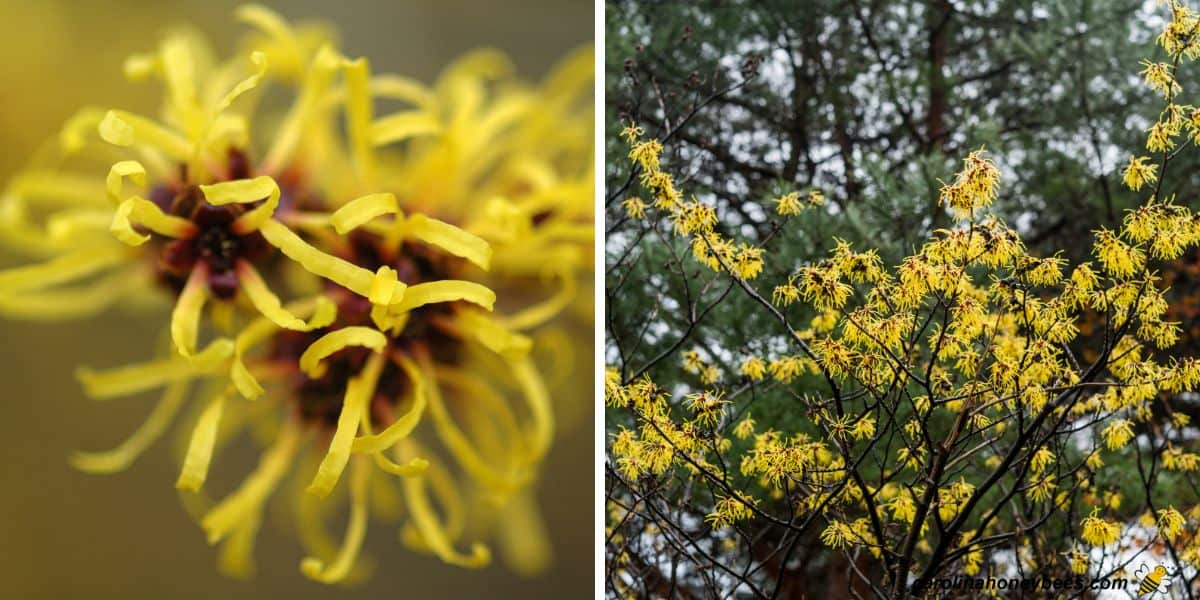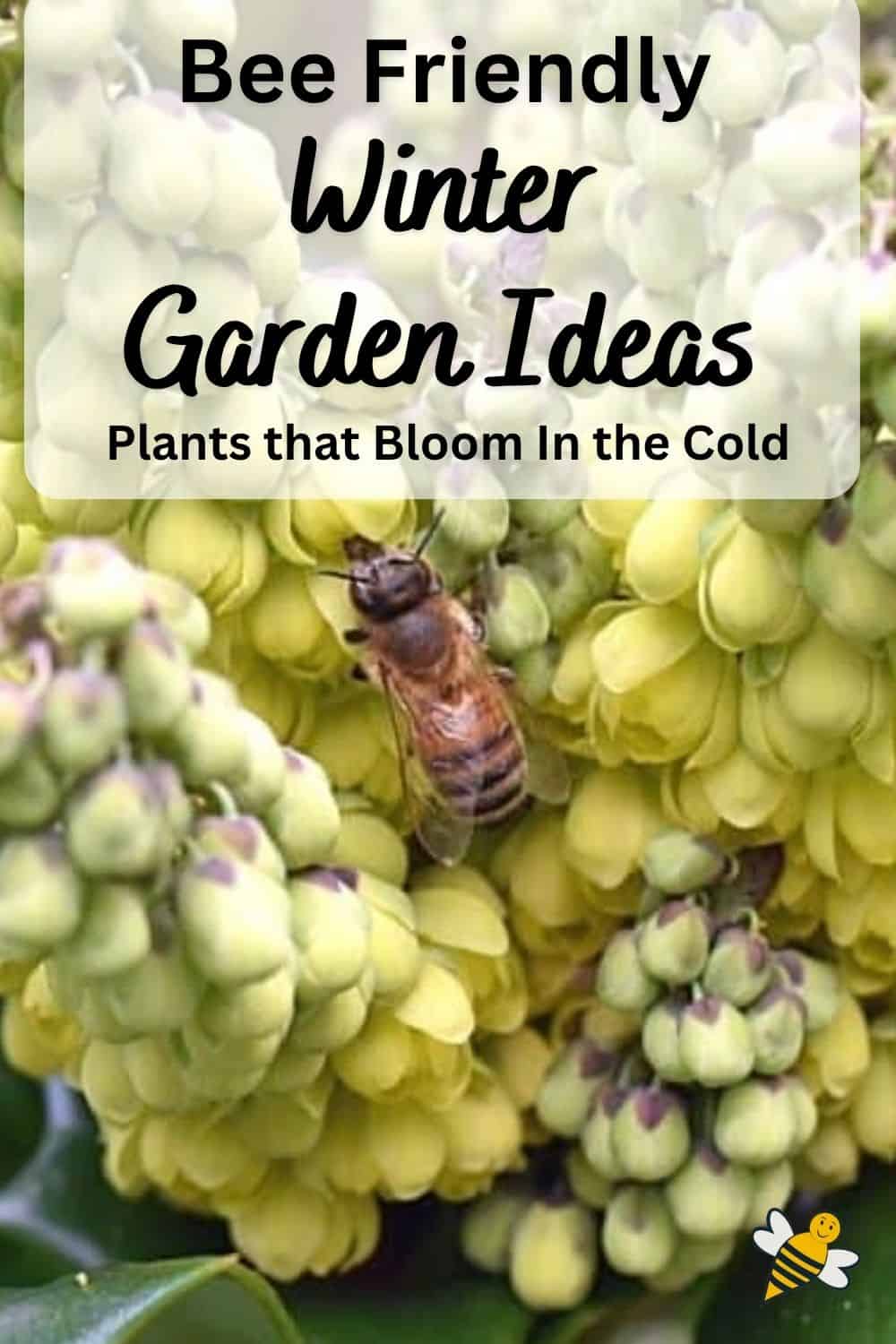Best Winter Plants for Bees & Pollinators
As the air turns colder and frost makes an appearance, we think less about bees needing to eat. Yet, in many regions winter plants provide important food resources for foraging bees. On those warmish winter days, workers will seek out any available food. You can help by adding some reliable winter flowers to your garden. When the weather allows, you may be surprised to see a variety of pollinators stopping by for a quick sip.

You don’t have to be a beekeeper to want to add more flowers that honey bees like to your landscape. I enjoy adding plants that bloom at various times of the year – its a great way to feed bees and beautify your outdoor spaces.
How Winter Plants Help Bees
Winter is tough for bees. Once the flowers fade, nectar and pollen become much more difficult to find. For honey bees, Winter is not a honey production time – for the bees (or us).
But, that does not mean the foraging bees (including bumble bees and other other insects) do not enjoy a fresh snack. That’s why having winter-blooming plants can be a lifesaver for a colony in need.
Pro-Tip: Late fall and early spring bloomers are just as valuable as true winter flowers. They help bridge the gap between the seasons when food is hardest to find.
Top Winter Plants for the Pollinators
Even when your garden looks bare, there are still some plants brave enough to bloom in the cooler weather. Be sure to add some to feed hungry pollinators and add some unexpected color to your winter garden.
Winter Blooming Shrubs Bees Love
One advantage of flowering shrubs is that they provide a large amount of nectar or pollen for bees. Most live for several years so you will not need to replant every years.
Bee-friendly bushes and shrubs can serve as a background for smaller plants or serve as a privacy hedge.
Mahonia (Mahonia aquifolium)

Mahonia, also know as Oregon Grape, is hands-down my favorite winter plant for bees. This spikey evergreen shrub can always be depended on for bee food.
When we occasionally have extreme cold for a few days ( 5° F), Mahonia’s bloom is damaged but not destroyed.
The shrub does have pointy leaves so choose a place on edges of the garden away from play areas. Very little maintenance is required once it is established but left untrimmed they can grow quite tall.
Camelia (Camelia spp.)

With more than 250 species and thousands of cultivars, choosing the best Camelia for your bee garden is not easy.
The two best known ornamentals in the US are Camellia japonica and Camellia sasanqua – and all the varieties that have been developed from them.
Both are evergreen shrubs that may grow quite tall. The blooms and leaves on Camellia japonica are larger and less fragrant that sasanqua. The bloom time varies a bit depending on the cultivar.
Camellias can provide an important source of nectar and food for pollinators during Winter. Be sure to select a cultivar that does well in your climate.
Native Witch Hazel (Hamamelis virginiana)

Witch-hazel begins to bloom in November with some flowers hanging on into December. The crinkly orange petals add beauty to the landscape and pollinators appreciate the free food buffet.
Paper Bush (Edgeworthia chrysantha)

This shrub is native to China and the Himalayas and provides a lot of beauty to the Fall and Winter garden. Large buds appear in Fall, followed by a cluster-like bloom in December.
Hardy in zones 7-10, it came be grown in zone 6 with some Winter protection. Edgeworthia can reach a height of 7 feet but you can keep it pruned to a smaller size. It makes a great background or specimen piece for the garden.
Winter Flowers for Your Garden
Not every plant need to be large and showy. On cooler days, bees often forage close to the ground. Here are some winter garden ideas for small spaces that add color and help feed bees.
Crocus (Crocus sativus)

Crocus are well-known harbingers or Spring. Their colorful flowers emerge from corms planted the previous Fall.
There are several different cultivars of Crocus that you can plant. I have seen my bees visiting different types and colors in my gardens.
One of the most beneficial things about them is that they return next year. Also, being quite cold hardy, a bit of snow or freezing weather does not ruin the bloom. A nice early food source that brightens up the bleak Winter landscape.
Winter Blooming Clemantis (Clemantis cirrhosa)

Normally thought of a Spring plant, there are several winter blooming Clemantis. Maintaining the classic twining form, some are evergreen and others are semi-evergreen.
Several cultivars are available which bloom times beginning in late December. Cleamatis cirrhosa var. balearica has creamy white flowers that provide nectar and pollen to hungry bees.
Hellebores (Helleborus spp.)

Hellebores are sometimes referred to as Christmas Rose. Their dark green shiny leaves add a bit of interest to the Winter shade garden.
These winter plants bloom when not many other natural food sources are available for bees.
When choosing hellebores for Winter bee food, look for the cultivars that have simple blossoms. Open-faced flowers with easy access to the nectar rich flower centers is best.
Hellebores are only one of many perennials suitable for the pollinator garden. But, they bloom for a long time – well into Spring.
Snowdrops (Galanthus)

Snowdrops are members of the Amaryllis family. They appear in late Winter and may emerge from a light snow cover. They provide rich pollen for honey bees that are able to forage on a warm day.
It is also wonderful to see something in bloom after the previous cold months. These winter plants are some of the first to appear.
Winter Aconites (Eranthis hyemalis)

Winter aconite is a member of the Ranunculaceae (buttercup) family. Native to Europe and parts of Asia, the plant produces bright yellow flowers (that are cup shaped) in late Winter.
They provide pollen and nectar to foraging pollinators.
Bulbs planted in groups give the best garden affect. They are poisonous though – so don’t plant in areas with pets or children.
More Winter Flowering Plants
Winter blooms sometimes surprise me. I will find them in unexpected places. But, even the small amount of pollen or nectar they provide can mean the difference of survival or not to a hungry colony.
Cold Tolerant Herbs That Attract Pollinators
If you live in an area with a milder or shorter winter period, some of your herbs may provide some nectar – even in the cool months. Check the particular cultivar for best growing conditions – consider:
- Rosemary – evergreen – fragrant – blooms in cool weather
- Thyme – blooms in mild winters
- Sage – hardy varieties may bloom late in the Fall season
A Special Nod to the Red Maple (Acer rubrum)

Not a bush, shrub or tiny plant, Red Maple trees are one of the earliest nectar and pollen sources for bees. The blooms appear long before leaves make their appearance.
Look for red tree tops in your area in late Winter and you may see bees foraging on red maple blooms. Though, sometimes the temperatures are too cold to allow the bees to fly.
Honey bees are not the only ones that benefit from the reddish blooms. Native bees are also attracted to them.
This native of the eastern deciduous forest, red maples are beautiful all year long. They grow fast and get rather tall. In the Fall, you will experience breath taking Autumn color.
Winter Garden Ideas for Bees
This is just a starter list – you will find many more plants to add to your Winter and early Spring garden – be sure to check with local nurseries.
As you design your landscape or yard, keep in mind the need for year-round pollinator food. Depending on your region, bees make be safely tucked away for several months or not.
For hungry pollinators in need of nourishment, even a few container bee plants can seem like a large buffet. In none freezing areas – don’t forget about a water source for bees too!
FAQs
Bees visit any blooming plant when temperatures are warm enough to fly. Honey bees are shipped across the country to pollinate plants such as almonds during the Winter months.
There are several pollen producing plants that bloom in Winter. Crocus, primrose and snowdrops can be seen blooming even when the ground is covered in snow.
Winter Honeysuckle (Lonicera fragrantissima) is a favorite of honey bees during Winter – but it can be an invasive plant in your region. Get the facts about invasive plants and bees before you plant this one.
A Final Word
Even in the quite of winter, your garden can still buzz with excitement. Choose the best winter plants for your bee friendly garden and help out some hungry bees. Even small spaces can make an impact and you get to enjoy the beautiful blooms.

